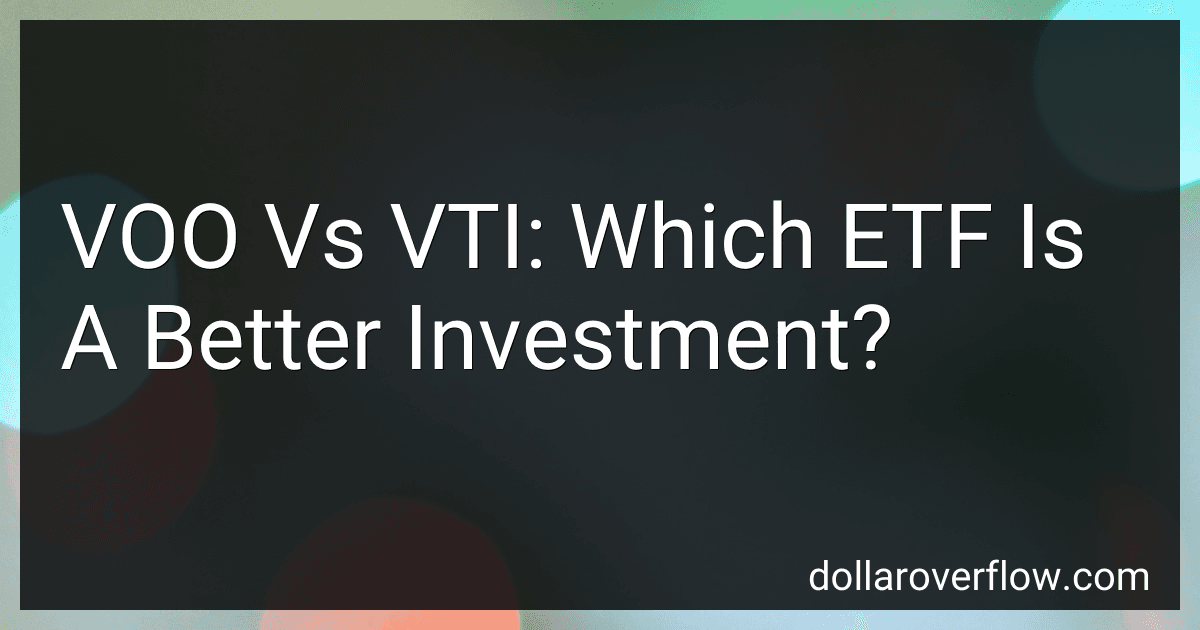When comparing VOO and VTI, it is essential to understand their differences and similarities to determine which ETF may be a better investment option for you. VOO is an exchange-traded fund that tracks the performance of the S&P 500 index, which represents 500 of the largest US companies. On the other hand, VTI is an ETF that seeks to replicate the performance of the CRSP US Total Market Index, which includes all US stocks listed on the NYSE and NASDAQ.
Investing in VOO provides exposure to large-cap companies, while VTI offers a more diverse portfolio that includes not only large-cap stocks but also mid and small-cap companies. VOO may be a better option for investors seeking stability and steady returns, as it includes established blue-chip companies. In contrast, VTI may offer greater growth potential due to its inclusion of smaller companies with more room for progression.
Another factor to consider when choosing between VOO and VTI is their expense ratios. VOO has a slightly lower expense ratio compared to VTI, which could impact your overall returns in the long run. Ultimately, the decision between VOO and VTI comes down to your investment goals, risk tolerance, and preferences. Both ETFs can be valuable additions to a diversified portfolio, but it is essential to evaluate your individual needs and investment strategy before making a decision.
How to compare the market capitalization of VOO and VTI holdings?
To compare the market capitalization of VOO (Vanguard S&P 500 ETF) and VTI (Vanguard Total Stock Market ETF) holdings, you can follow these steps:
- Visit the official Vanguard website or any trusted financial website that provides information on these ETFs.
- Look for the latest data on the market capitalization of each ETF. This information is usually provided in the fund overview or fact sheet section.
- Calculate the total market capitalization of each ETF by multiplying the share price of each holding by the total number of outstanding shares.
- Compare the total market capitalization of VOO and VTI to determine which ETF has a higher market capitalization.
By following these steps, you can easily compare the market capitalization of VOO and VTI holdings and make an informed decision based on your investment goals and preferences.
How to compare the historical performance of VOO and VTI during market downturns?
To compare the historical performance of VOO (Vanguard S&P 500 ETF) and VTI (Vanguard Total Stock Market ETF) during market downturns, you can follow these steps:
- Look at historical data: Start by analyzing the historical performance of both VOO and VTI during past market downturns. You can look at the percentage change in the value of each ETF during these periods.
- Compare the drawdowns: Determine the maximum drawdown for both VOO and VTI during market downturns. A drawdown is the peak-to-trough decline in the value of an investment before a new peak is reached. This will give you an idea of how much each ETF declined during a market downturn.
- Analyze the recovery period: Look at how quickly both VOO and VTI recovered from market downturns. Some investments may take longer to bounce back, while others may recover more quickly.
- Consider the underlying holdings: VOO tracks the S&P 500 index, which consists of the 500 largest publicly traded companies in the U.S. VTI, on the other hand, tracks the CRSP US Total Market Index, which includes a broader range of U.S. stocks. Consider how the underlying holdings of each ETF may have impacted their performance during market downturns.
- Consult a financial advisor: If you are unsure about how to interpret the historical performance data of VOO and VTI during market downturns, consider consulting a financial advisor. They can provide you with personalized advice and help you make informed investment decisions based on your individual financial goals and risk tolerance.
What is the expense ratio for VOO and VTI ETFs?
The expense ratio for VOO (Vanguard S&P 500 ETF) is 0.03% and for VTI (Vanguard Total Stock Market ETF) is also 0.03%.
What is the asset allocation strategy of VOO and VTI?
VOO is an exchange-traded fund (ETF) that tracks the performance of the S&P 500 index, while VTI is an ETF that tracks the performance of the total US stock market.
The asset allocation strategy of VOO and VTI is focused on providing broad exposure to the US stock market, with VOO specifically focusing on large-cap stocks represented in the S&P 500 index, and VTI providing exposure to stocks of all market capitalizations in the US stock market.
Both VOO and VTI have a diversified portfolio of stocks across various sectors of the US economy, providing investors with a way to gain exposure to the overall performance of the US stock market. The asset allocation strategy of both funds is designed to provide investors with a way to achieve long-term growth through investing in a diversified portfolio of US stocks.
